Does Two Lines on a Pregnancy Test Mean Im Pregnant
When you're trying to get pregnant, you may feel eager, excited, and anxious when taking pregnancy tests. You want to see an easy-to-read result. Unfortunately, the reality of taking pregnancy tests is that the results can sometimes be challenging to interpret.

Faint lines, evaporation lines, indent lines, and more can put a damper on your pregnancy testing experience. Instead of getting excited about the results, you may find yourself confused or disappointed by a difficult-to-read result.
This blog post will teach you how to make sense of confusing pregnancy test lines — including faint lines, evaporation lines, and indent lines — so you can go into your pregnancy testing experience feeling confident and capable of interpreting your test.
The Different Types of Pregnancy Tests and How They Work
Home pregnancy tests use the concentration of the pregnancy hormone hCG found in your urine to determine whether or not you are pregnant. They do this by comparing your hCG levels to an average threshold of hCG found in early pregnancy.
Most pregnancy tests show two lines: a control line and a test line. The control line appears to show that you have tested properly, while the test line appears only if the test determines that you are pregnant. These lines are called "indents," where the ink pools into one or two lines to show if you are pregnant or not.
You generally have the choice between three types of home pregnancy tests: mid-stream, dropper, and dip tests.
- Mid-stream tests are held in your urine stream for several seconds (after it has already started).
- Dropper tests use a dropper to extract fresh urine from a cup, which is poured inside the testing well.
- Dip tests use test strips that are directly submerged into a cup of collected urine.
For each of these options, it's important to read the instructions and follow them closely for an accurate result. Often, you must wait a few minutes before the pregnancy test shows a result.
You should also make sure to take a pregnancy test at the right time — typically two weeks after the date of ovulation (read more about how to use ovulation test strips correctly) — to ensure you do not receive a false-positive or false-negative result.
After a few minutes, you can look at the test window to determine the result of your pregnancy tests.
Some newer, digital pregnancy tests use a plus or minus sign, or words like "yes" or "pregnant" to make the results less confusing. However, most pregnancy tests use a test line and a control line. When the test line is faint or evaporated, it can be challenging to determine whether you are actually pregnant.
Interpreting the Results
Pregnancy tests try to make the testing process as simple as possible. Unfortunately, some confusion when interpreting the results is unavoidable — especially if your test line comes back light or faint. Here's what you need to know about making sense of the different types of lines that can appear on a pregnancy test result.
What should a positive test look like?
In a perfect world, all positive pregnancy tests would look the same and be easy to interpret. However, each manufacturer uses a different system to tell if you are pregnant or not. Some of the symbols that might be used to indicate a positive test result include:
- The word "yes" or "pregnant"
- A smiley face
- A plus sign
- Two dark lines, either parallel or in the shape of a plus sign
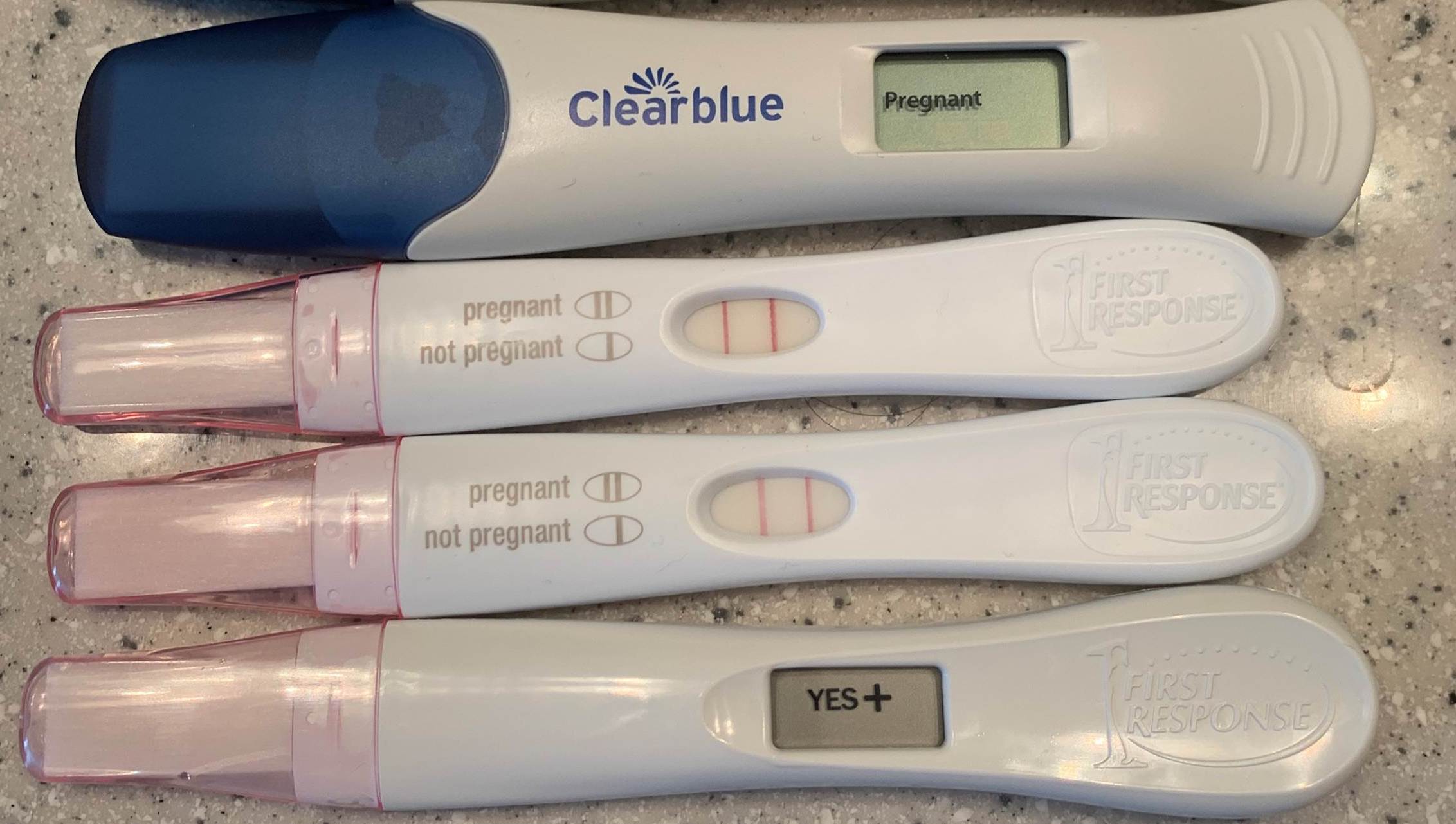
Source: Mira Fertility Club Facebook Group
When these symbols appear, you can feel confident that, as long as you have tested at the right time and followed the directions, you are likely pregnant. Your doctor can follow up with an hCG blood test to confirm the result of the home pregnancy test.
Evaporation (Evap) Lines
Pregnancy tests have a reaction time — a period of approximately three-to-five minutes after they're taken when the urine used in them is still damp. The result appears after this three-to-five minute window. However, if you wait too long after the reaction time to interpret the result, the urine in the pregnancy test can dry up, resulting in an evaporation line.
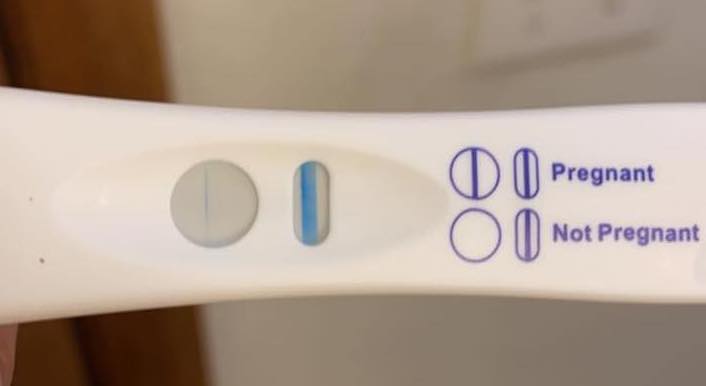
Source: Mira Fertility Club Facebook Group
Evaporation lines are considered false-positive results. Unlike a faint positive result, which will result in a light pink or blue line, an evaporation line does not activate the dye in the pregnancy test, so it may show up as a colorless or translucent line. In addition to happening when you wait too long to interpret the test, it may also occur if the test gets wet or is taken incorrectly.
Anytime you see a faint line and are unsure if it means you are pregnant or not, the best thing to do is to repeat the pregnancy test with a new test strip.
Faint Lines
Occasionally, a faint line on a pregnancy test means that you are pregnant. Other times, it may indicate a false-positive result. Usually, the cause of a faint line on a pregnancy test is testing too early.
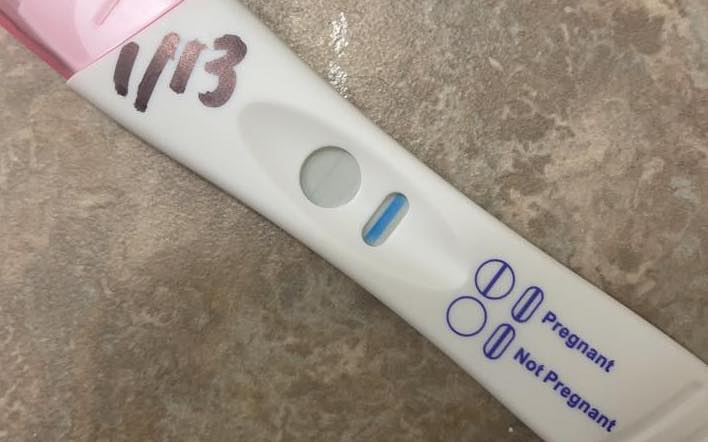
Source: Mira Fertility Club Facebook Group
In early pregnancy, your hCG levels rise gradually. A faint line could be the result of hCG levels that are rising, but not very far above the threshold to indicate that you are pregnant. However, it may also be the result of a chemical pregnancy, a false-positive test result that comes from taking a pregnancy test too soon before the start of your next menstrual period.
The best thing to do if you see a faint line on a pregnancy test is to wait and test again. Make sure that you do not take the second pregnancy test sooner than two weeks after the date of your ovulation, as your hCG levels may not be high enough to produce a clear positive result if you test before then.
If you are pregnant, testing again in two weeks should result in a darker, clearer test line, since your hCG levels will continue to rise. If the faint line was the result of a chemical pregnancy test, you may receive a negative test result when you test again.
Occasionally, faint lines on a pregnancy test can be due to health issues such as ectopic pregnancy, pituitary gland tumors, or ovarian cysts. If you continue to see faint lines when you repeat a pregnancy test, visit your doctor for an hCG blood test to determine if you are pregnant and so they can rule out any serious medical conditions.
Indent Lines
Indent lines are the two lines — the control line and the test line — that fill with ink when you take a pregnancy test. They are named this way because they are slightly indented so the ink will not spill out.
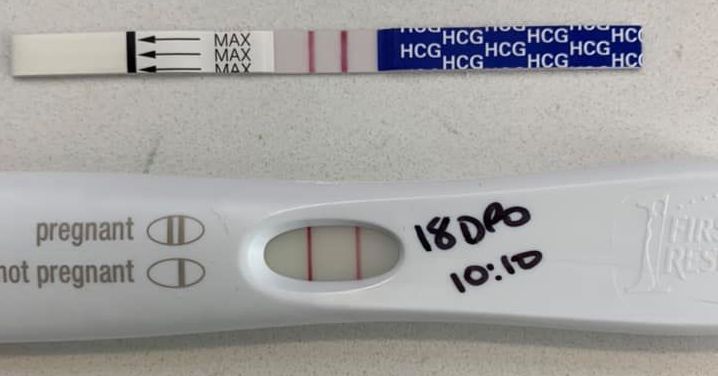
Source: Mira Fertility Club Facebook Group
When you are pregnant, both indent lines will fill; if you are not pregnant, only the control line will fill. If neither line fills, it is an indication that the pregnancy test was either taken incorrectly or is defective, and you should repeat the test.
Sometimes, as the ink moves across the test window, a small amount of ink gets stuck in the second indent line (the test line). As the pregnancy test begins to dry, your urine starts to evaporate, pulling the small amount of stuck ink up to the top of the line. This can result in a faint evaporation line or false-positive result.
For this reason, it's especially important to read the directions on the pregnancy test, particularly when it comes to how long you should wait. Set a timer so that you do not accidentally wait too long before interpreting the results, and make sure you keep the pregnancy test flat while it dries so that the ink will not fill the indent line and give you a false-positive result.
Lines with No Colors
Some faint lines on pregnancy tests are the same color as the control line: pink or blue. Other times, the lines show up clear or colorless. As we mentioned previously, this can happen when the urine on the test dries and starts to evaporate.
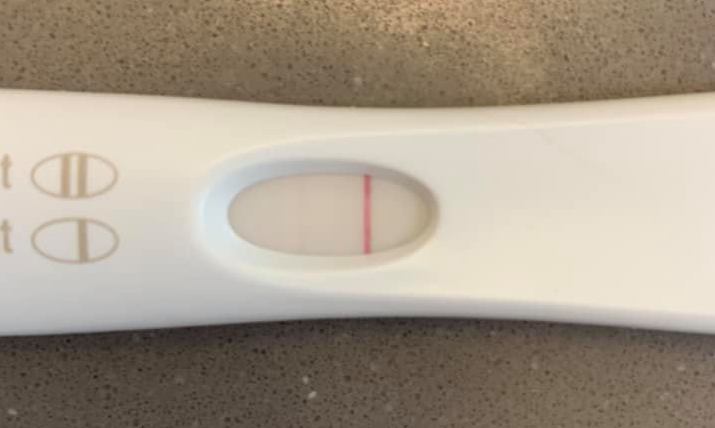
Source: Mira Fertility Club Facebook Group
This evaporation line shows up as a clear or colorless line in the test indent. Even though it can trick you into thinking you are pregnant, it's important to know that evaporation lines are false-positive results.
You can always repeat the pregnancy test if you are confused about an evaporation line — just make sure to follow the directions closely and not to wait too long before interpreting your results so you don't wind up with a second false-positive test.
Tips on Preventing False Positives or Negatives
When taking a pregnancy test, it's important to follow the directions exactly to avoid getting a false-positive or false-negative result. Taking a home pregnancy test incorrectly is one of the most common causes of confusing test results. Follow these practical tips, in addition to the directions for your specific pregnancy test, to reduce the likelihood of false positives or false negatives:
Don't Test Too Early
Wait at least two weeks after the day of ovulation, or one day after the date of your expected period, to increase accuracy. Taken at this time, home pregnancy tests are up to 99% accurate. You can pinpoint the day of your ovulation with greater accuracy using a digital fertility tracker like Mira.
Test More Than Once
Test more than once, especially if you are confused by the results of your pregnancy test. More than one positive pregnancy test result makes it more likely that you are actually pregnant, rather than receiving a false-positive result.
Test in the Morning
Take the pregnancy test using your first urine of the morning. Your hCG concentrations are the highest first thing in the morning, so if you are pregnant, you will decrease the likelihood of a false-negative result by testing using your first urine of the day.
Follow the Instructions
Read the instructions prior to taking the test and follow them closely. Set a timer for the exact waiting period so you do not accidentally wait too long and see an evaporation line. Most pregnancy tests will also tell you to keep the test strip flat while you are waiting for the results.
Know That Not All Tests Are Created Equal
If you are confused by the results of your pregnancy test, try a different type of home pregnancy test. Some people find pink dye or blue dye easier to see. Others may prefer a digital pregnancy test that uses a word like "yes" or "pregnant" to give a clear result.
Check for Other Pregnancy Symptoms
Check for other pregnancy symptoms. Early pregnancy symptoms include breast swelling or tenderness, nausea or vomiting ("morning sickness"), and missed periods. Combined with a faint positive line, these symptoms make it more likely for you to be pregnant.
See Your Doctor
If you're still concerned about home pregnancy test results, schedule an appointment with your doctor. You may be able to have blood tests done to see if your hCG levels rise. Hopefully, you'll get the exciting answer you're looking for.
Does Two Lines on a Pregnancy Test Mean Im Pregnant
Source: https://www.miracare.com/blog/evaporation-line-on-a-pregnancy-test-positive-or-negative/
0 Response to "Does Two Lines on a Pregnancy Test Mean Im Pregnant"
Post a Comment